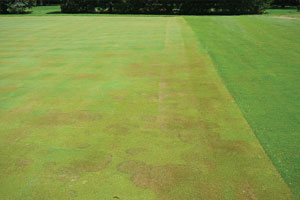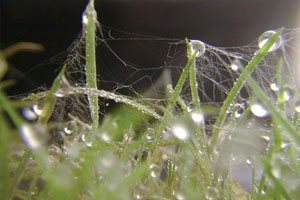Brown Patch Overview
Brown Patch is a common disease caused by the soilborne fungus Rhizoctonia Solani. It causes foliar blighting of nearly all cool season turfgrass species, which include creeping Bentgrass, Perennial Ryegrass, Poa spp. and Tall Fescue. Read on to learn more.
Overview
The problem
Brown Patch is a common disease caused by the soilborne fungus Rhizoctonia Solani. It causes foliar blighting of nearly all cool season turfgrass species, which include Creeping Bentgrass, Perennial Ryegrass, Poa spp. and Tall Fescue. Brown Patch can cause significant damage in the spring through to autumn, with the highest risk in the summer. Although all cool season turf species are affected, many Colonial Bentgrass varieties are highly susceptible to Brown Patch.
What to look for
Brown Patch is most active in warm, wet conditions, when minimum temperatures are above 15°C and daily leaf wetness periods are 10 hours or more. Nighttime temperatures above 20°C with extended leaf wetness are associated with severe Brown Patch outbreaks on golf course turf. Disease development is often greater in areas with saturated soils/poor drainage. Activity is often triggered by thunderstorms that cause localised flooding.
Brown Patch occurs in irregular circular patches about 30–90 cm in size. Early in the morning, the outermost Brown Patch edge may be bordered by a ‘smoke ring’ of Mycelia. Initial infection has a water-soaked appearance but as the foliage dries, the infected leaves will become necrotic/brown. On high mowed turf, such as Tall Fescue, irregular tan lesions with a chocolate-red border may be seen on leaf blades.
Brown Patch can be confused for pythium blight. Rapid diagnosis and selecting the right treatment are essential for management of Brown Patch.
The solution
Brown Patch management requires an integrated approach:
- Avoid excessive amounts of nitrogen (N); spoon feeding N at low rates in the summer is recommended.
- Schedule irrigation at night, from midnight to early morning to minimise periods of prolonged leaf wetness.
- Increase air movement by addressing excessive tree and shrub growth on the golf course.
- Installing fans in areas near golf greens where stagnant air is a problem can reduce brown patch pressure significantly.
Whenever possible, the mowing height should be adjusted higher because low mowing heights are associated with greater Brown Patch development. Core aerification will reduce thatch accumulation. This also helps to improve drainage. Avoidance of highly susceptible turf species, such as Colonial Bentgrass, is warranted in humid areas where Brown Patch is most problematic.
Preventive applications are more effective than curatives; Brown Patch causes disease quickly and significant injury to turf can occur prior to curative treatment. Additionally, all cool season turfgrasses have poor recuperative potential during midsummer, a time when brown patch activity peaks. Preventive fungicides to target Brown Patch should begin late spring/early summer when low (night) temperatures exceed 15°C consecutively for two to three days.
There are a number of choices for controlling Brown Patch, and all Envu solutions provide added control of other diseases that can be active at the same time. Interface®Stressgard and Dedicate Forte®Stressgard provide broad-spectrum control of Brown Patch and Dollar Spot. Dedicate Forte Stressgard also provides control of Anthracnose.
Fungicides with Stressgard®Formulation Technology can help reduce summer stress on turfgrass. Interface has shown high turf quality results when applied in summer programs and provides excellent control of brown patch. Signature™ Stressgard® promotes plant health and reduces the effects of summer decline and R. Solani as shown in numerous university trials. You can find more information on summer decline here.
Technical Information
 |
 |
 |
(L) Brown patch severely affecting a creeping bentgrass nursery green in early summer. (C) Brown patch affecting a creeping bentgrass fairway in late summer. (R) Creeping bentgrass with leaf wetness and active brown patch mycelium present. Photos by Dr Derek Settle, Bayer CropScience. As of 4th Oct 2022, the Environmental Science division of Bayer was divested and transferred to Envu. Note that this content was produced prior to separation.
| Solution1 | Rate | Application Interval |
| Interface® Stressgard | 12 L/ha | 14–21 days (curative) 21–28 days (preventative) |
| Dedicate Forte® Stressgard | 3.5 L/ha | Apply on a 14-28-day spray interval when conditions are favorable for disease development. Use the shorter spray interval under high disease pressure or for curative treatment. |
To find out more information about our products and services, reach out to our team.
Always read the label before use.
Back to Other Diseases